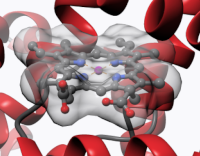Reading List
A list by Biophysics Colab
Articles that are being read by Biophysics Colab.

Showing page 28 of 55 pages of list content
-
Structural and biophysical analysis of a Haemophilus influenzae tripartite ATP-independent periplasmic (TRAP) transporter
This article has 19 authors:This article has been curated by 1 group:Reviewed by eLife
-
Structural dynamics at cytosolic inter-protomer interfaces control gating of a mammalian TRPM5 channel
This article has 4 authors: -
Divergent folding-mediated epistasis among unstable membrane protein variants
This article has 10 authors:This article has been curated by 1 group:Reviewed by eLife
-
A conserved ion channel function of STING mediates non-canonical autophagy and cell death
This article has 7 authors: -
Chloride intracellular channel (CLIC) proteins function as fusogens
This article has 8 authors: -
Cryo-EM architecture of a near-native stretch-sensitive membrane microdomain
This article has 15 authors: -
-
Observing Mechanosensitive Channels in Action in Living Bacteria
This article has 3 authors: -
Cryo-EM structures of human magnesium channel MRS2 reveal gating and regulatory mechanisms
This article has 4 authors: -
Structures of wild-type and a constitutively closed mutant of connexin26 shed light on channel regulation by CO2
This article has 5 authors:This article has been curated by 1 group:Reviewed by eLife
-
-
-
-
-
Structural basis for hyperpolarization-dependent opening of human HCN1 channel
This article has 9 authors: -
Predicting Relative Populations of Protein Conformations without a Physics Engine Using AlphaFold2
This article has 5 authors:Reviewed by PREreview
-
Structural basis of allosteric modulation of metabotropic glutamate receptor activation and desensitization
This article has 13 authors: -
CryoEM structures of the human CLC-2 voltage-gated chloride channel reveal a ball-and-chain gating mechanism
This article has 10 authors:This article has been curated by 1 group:Reviewed by eLife
-
Insertases scramble lipids: Molecular simulations of MTCH2
This article has 3 authors: -
An ancestral dual function of OmpM as outer membrane tether and nutrient uptake channel in diderm Firmicutes
This article has 11 authors: